|
Invasive Exotics Are Taking Over!
Stephen O'Philips
Frederick County Master Gardener Program
Remember the movie 'Species', in which a life form biologically superior to human life threatened to out-breed and take over the human race? Well, the sky is not falling, and Frederick County is not being invaded by extra-terrestrial plant
species. However, Frederick County agricultural and forest lands are being subjected to imported trees, shrubs and vines, primarily from Asia, and to a lesser extent from Europe.
These species are called 'invasive exotics' because their growth rate is aggressive and rapid. They tend to leaf-out before native plant species, and thereby shade emerging native plant species. This shading factor further retards the growth
of native plants, and gives the exotic invasive species a head start on the growing season. As a result of this aggressive growth factor, invasive exotics are out-competing native, American plant communities.
Areas of land which are subject to disruption of an equilibrium state (formerly called an ecological climax condition) are increasingly being re-populated with non-native, invasive exotics. Farming operations, timber harvesting, forest
fires, construction activities and any other types of clearing activity may subject land to seedling growth from invasive exotics if mature, invasive exotic trees/shrubs of seed bearing capability are present in the area of disruption. In some cases, disturbed area or
abandoned farmland regrow 80-90% in invasive exotic plants.
The Number One tree problem in Frederick County (and much of the mid-Atlantic area) is Ailanthus altissima or tree of heaven. This aggressive tree was imported to the United States many years ago, and was sold in the nursery business because
of its hardiness, fast growth, and tolerance of smoke, dust and pollution. It also produces beautiful yellow and orange flower clusters that emerge in July and August.
Unfortunately, once this plant gets a toehold, native, American species cannot match the growth rate, and they become 'shaded out' and eventually die. Normally, cutting this tree down just causes it to spread and re-grow prolifically from
stump sprouts and root suckers.
|
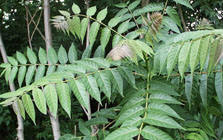
Tree of Heaven
Ailanthus altissima
|
Additionally, Tree-of-Heaven is useless for structural wood, and is not even desirable for firewood or wildlife. Significant areas of forest are being regenerated in Tree-of-Heaven--displacing native trees, which have greater value for wood
products and wildlife-- and thus, there is no economic incentive to use these infested lands for timber harvesting.
Another tree problem is Acer platanoides, commonly called Norway maple (also, its several cultivars, such as 'Crimson King', 'Variegata', etc.).
|
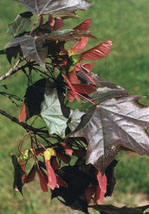
Norway maple
Acer platanoides
|
This tree is actually a distant second, in terms of its disruptive influences on native, American tree communities, but it is something, which should be monitored. More disturbing are a number of exotic shrub and vine species, which are
extremely aggressive in their growth rate.
In the Frederick County area, the most obnoxious of the shrub/vine category is Rosa multiflora, or multiflora rose. This aggressive shrub is burdensome to many farmers whose croplands are infested with it.
The USDA Soil Conservation Service
imported Multiflora Rose, unfortunately, in the 1930's to control the severe erosion problems experienced by farmers during the Dust Bowl of the early 30's. Unfortunately, these soil scientists did not realize that Multiflora Rose would one day breed out of control.
|
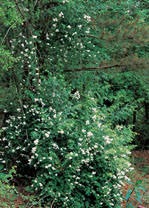
Multiflora Rose
Rosa multiflora
|
There is a grass roots movement afoot, called 'Responsible Gardening', which attempts to persuade home-owners to avoid using invasive exotics, especially those home-owners living near open areas, agricultural lands or forests. The Frederick
County Planning Staff has been indicating--on all recent Site Plan reviews--that landscape plant lists should not
contain invasive exotics, in order that their use in manmade landscapes will not further the spread of invasive exotics to forested and agricultural areas in Frederick County. Lastly, there is the ethic of preserving native, American plant
(and animal) communities for their intrinsic values, aside from economic values of lost timber income. The presence of invasive exotics changes the dynamics of not only plant, but also animal wildlife because native animals are dependent on native plant species for food.
Below is a list of the most invasive of the exotic plant species (established by the Frederick County Planning Office, in their order of invasiveness for each type of plant) currently plaguing native, American plant communities in Frederick
County:
Trees:
|
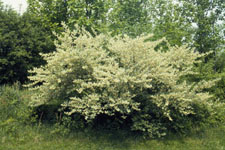
Autumn Olive
Elaeagnus umbellata
|
|
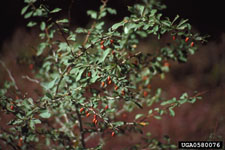
Japanese barberry
Berberis thunbergii DC
|
- Ailanthus altissima (Tree of Heaven)
- Acer platanoides (Norway Maple including cultivars 'Crimson King','Variegata', etc.)
- Elaeagnus angustifolium (Russian Olive)
- Elaeagnus umbellata (Autumn Olive)
- Morus alba (White Mulberry)
- Prunus avium (Sweet Cherry/Bird Cherry)
- Paulownia tomentosa (Empress Tree)
Shrubs:
- Rosa multiflora (Multiflora Rose)
- Lonicera ssp. (Bush Honeysuckle including cultivars'Belle','Amur','Morrows',& 'Tartarian')
- Berberis thunbergii (Japanese Barberry)
- Spirea japonica (Japanese Spirea)
Vines:
- Lonicera japonica (Japanese Honeysuckle
- Celastrus orbiculatus (Oriental Bittersweet)
- Vinca minor (Periwinkle/Vinca)
- Hedera Helix (English Ivy)
Read other articles on ecological gardening & native plants |